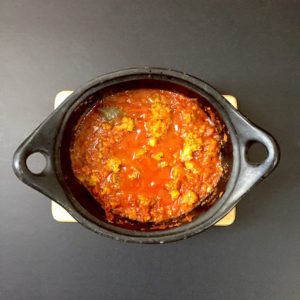Niloufer’s Tomato Chutney
Chutney was the result of feeling in a cooking rut and wanting to make something different. Granted, this isn’t (fill in complicated recipe here), but it’s new to me.

Yes, they need replacing.
The original recipe comes from Niloufer Ichaporia King’s My Bombay Kitchen, a book that’s accessible even to those daunted by Indian cooking.The ingredients-lemons, limes, lemongrass, lots of garlic, cayenne, and hot peppers, will be familiar to anyone who cooks Southeast Asian food.

Before going any further, I realize it’s very late in tomato season to be giving a recipe, perhaps even too late in some places. So know that Madhur Jaffrey gives a nearly identical recipe for Sweet Tomato Chutney in her seminal An Invitation To Indian Cooking. The major difference is she calls for canned tomatoes.

Chutney is the Wayne Gretzky of the preserved food world. When asked to coach the Arizona Coyotes, Gretzky had to resign: even he, The Great One, had no idea how he did what he did. (894 goals, 1963 assists). He was therefore unable to teach anyone else how to do it. This may seem an odd analogy–particularly if you don’t follow hockey. What I mean is whereas most canning recipes follow strict guidelines concerning preparation, vinegar type and acid level (5%!!), canner type (either water bath or pressure), how much food goes into the jar, whether it’s packed hot or raw, amount of time the food spends in the canner, and so on, chutney flouts most of these rules.

You want to be sure your chutney includes preservative ingredients like sugar and vinegar, and those in adequate amounts. You need to make decisions about storage: cupboard or refrigerator? Will you can it or not?

Being American, and therefore squeamish, I suggest you either refrigerate or water bath can your chutney. A water bath is ideal, as you then have a shelf-stable product. If you don’t have a water bath canner, a deep pot and a cake rack make a fine improvised canner.

Canner with cake rack.
Beyond this, what you put into your chutney–raisins, currants, almonds, cayenne, cinnamon–is up to you. Rather than yammer on here, I feel it’s best to give the recipe and log out. Or this post will go up at Thanksgiving.

If you’re wondering what you’ll do with chutney, consider this: as I write, the hot pepper harvest has been impacted due to drought and worldwide unrest. This, in turn, is causing shortages of the world’s most beloved hot sauces.

We hot sauce lovers are being thrown back on ourselves. Rather than search out scarce bottles, we can make our own hot sauces. Niloufer’s Tomato Chutney was easy–I mean, I made it while recovering from Covid. I was, shall we say, a hot mess.
Use Niloufer’s Tomato Chutney anywhere you’d use commercial hot sauce–with Indian food, of course, but also atop rice, with meatloaf, in sandwiches, spooned over noodles. Use your imagination.

Niloufer’s Tomato Chutney
Recipe adapted from My Bombay Kitchen, by Niloufer Ichaporia King
Canning safety information comes from Joyce Goldstein’s Jam Session and
The USDA Complete Guide to Home Canning and Preserving, Second Edition
Yield: Two pounds/one kilo tomatoes yielded 3 pint jars (474 ml each) and one half-filled jar of chutney (approx 200ml)
Preparation time: The chutney needs about 3 hours cooking time on the stove. This needs occasional stirring. Chutney then needs to sit overnight to settle. The next day it may be poured into jars and either water bath canned or refrigerated. See below for discussion.
Please read notes before cooking.
4-6 pounds [1-2 kilos] organic tomatoes, any type
3/4 cup/150g garlic
1/4 cup/30g ginger
1/2 cup/113 g white sugar
2 cups/474 ml cane vinegar
2 tablespoons cayenne pepper
3 tablespoons canning or sea salt
Peel the tomatoes. To do this, bring a large pot of water to boiling. Drop a few tomatoes in at a time. After a few minutes, fish one tomato out with a slotted spoon. The skin should easily slip off. If not, drop it in a few minutes more.
Leaving the skins on isn’t awful, it just makes the finshed chutney less pleasant to eat.
Once the tomatoes are all skinned, slice them in half and toss them into a large pot. I used my 5quart/liter enameled Staub for this.
Once tomato water is cooled, water the outside plants with it.
Peel and thinly slice the garlic cloves. Add to tomato pot.
Peel and thinly slice the ginger. Add to tomato pot.
Add remaining ingredients to pot and bring to boil, then turn down to medium simmer. The chutney will need stirring every now and then for the next three-four hours. I had difficulty getting a simmer that didn’t turn into a high boil, so put my pot on a flame tamer.
Over the next few hours you’ll notice the chutney cooking down and thickening. When it’s like a very thick tomato sauce, take it off the heat and either pour it into a large bowl or leave it in the pot. Either way, allow chutney to cool completely before covering and refrigerating it overnight.
In truth, I left my chutney two days.
To can the chutney:
Taste it for, as Ms. King writes: “Sweet! Sour! Salty! Hot!” and adjust accordingly. My chutney is extremely spicy. Yours need not be.
Prepare a water bath canner or large, deep pot. Place canner rack or cake rack in bottom of pot. Fill almost to top with warm water, remembering Archimedes in his bathtub, or that the water must cover the jars by three inches. Turn heat to low, to give you a jump start on the canning process.
To sterilize jars: either run them through dishwasher or wash in hot soapy water and place in low oven. How many jars? Better to wash too many than find yourself short in the moment.
Rinse jar lids in warm soapy water. Place in small pot filled with warm water over low heat.
Heat chutney in large pot to low simmer. Pour into jars with clean ladle. You want to fill jars allowing 1/4 inch headspace. You’ll notice a glass line running around the top of the jar; stop there. A funnel is extremely helpful in avoiding spills. Screw on lids fingertip tight.
I use a dishtowel to grip hot jars while putting lids on.
Lower jars into canner with jar lifter.
Once jars are filled, bring heat up to high. Once water is boiling, turn down slightly–it doesn’t need to be going insane, just boiling–and boil for 12 minutes (my compromise between 10 and 15.).
After 12 minutes, turn off heat and allow jars to rest 5 minutes. Lift out with jar lifters and place on wooden surface. Leave to cool for at least 12 hours before testing seal.
Keeps for two years. Once jars are opened, refrigerate.
Any leftover chutney that doesn’t fill a jar may be refrigerated for immediate consumption.
If jars fail to seal, you can reprocess or just refrigerate. Canning tips below.
Notes:
While these notes are long, do not be put off. Chutney is easy to make and requires no special equipment.
All of the ingredients given are amounts I used. You may increase or decrease everything but the vinegar. For safety reasons, that must be 2 cups.
Your tomatoes will be different, so your yield may vary.
Do not use iodized salt. Use canning or fine sea salt.
Ms. King’s recipe uses 4 cups (500 grams) of sugar. I used only 1/2 cup (4 ounces, or 115 grams. The amount of sugar is a matter of personal choice. Much about chutney making is. In this, chutney differs from most preserved foods, which are quite specific about amounts for safety reasons. Read a few chutney recipes, or many, as I did, and you’ll notice a lassiez faire attitude toward chutney ingredients. Want to toss in some raisins? Go for it. Hot peppers? Why not? Don’t have enough white sugar? Brown is just fine.
The original recipe calls for cloves, a cinnamon stick, raisins, and optional orange peel. Feel free to add these.
Ms. King suggests cane, malt, or cider vinegar. Whatever you use, be sure it has 5% acidity. Any lower, and you risk botulism toxin.
Sharper eyes will notice the tomatoes are unpeeled. Not for lack of trying. Normally tomatoes may be plunged into boiling water for a few minutes and their peels will obligingly slip free. Not these babies. I finally gave up and poured the water into the parched soil beneath my lemon tree.
Canning tips:
Keep jar rims clean. If you spill the chutney, wipe rims with clean cloth or paper towel dipped in white vinegar.
Never eat food from a failed jar–unless you refrigerated it. If you find a failed seal days or months later, toss it.
Use water from canning to wash dishes or water plants. It’s clean.





